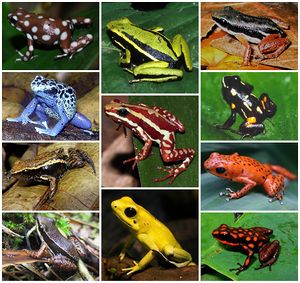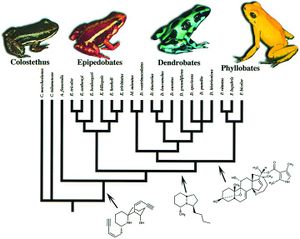Evolution in Family Dendrobatidae (Poison Frogs)
Introduction
The family Dendrobatidae, part of the class Amphibia, and more broadly, the kingdom Animalia, are a group of toxic frogs. These animals are commonly referred to as poison arrow frogs, dart poison frogs, or poison dart frogs. Frogs within this family are found living in the tropical climates of Central America and the northern portion of South America. They are usually small in size, and are known for their vivid coloration, although there are exceptions to this trait. Their diet consists of ants and mites, which research has suggested are suppliers of the precursor molecules that make up the amphibians toxins. Frogs in this family derive their common name from the Columbian practice of rubbing blow darts on the backs of frogs to coat them in poison for hunting. They produce alkaloid poisons, and some of the most highly toxic ones known at that. Many species’ toxins are strong enough to be lethal to vertebrates in even a small dose. [1][2][3]

Other examples:
Bold
Italic
Subscript: H2O
Superscript: Fe3+
Evolution
Coloration and Toxicity
Members of the amphibian family Dendrobatidae are considered to be aposematic, meaning their coloration serves as an adverse warning that protects them from predation. For this notion to be true, it is implied that the frogs’ bright appearance and toxicity would have evolved in parallel. Research conducted by Summers and Clough set out to prove this hypothesis. Previously to this study, investigations of this hypothesis failed to account for phylogenetic relationships, which can cause a bias in results. Summers and Clough, however, made use of mitochondrial DNA from the gene regions cytochrome b, 12s RNA, and 16s RNA, in order to create a phylogenetic basis for their study. From this they developed four genera within the Dendrobatidae: Phyllobates, Dendrobates, Epipedobates, and Minyobates. This wide range of diversity within the family lead the researchers to a comparative method of analysis. For the twenty one representative species from each of the four genera examined in the study, data on toxicity was collected from literature, and coloration rated by both human observers and a computer program. When determining evolutionary correlation between the two phenomena, Comparative analysis on the data using models of both gradual and punctuated evolution showed that they were significantly correlated. The work of Summers and Clough effectively proved that frogs in the family Dendrobatidae, are in fact, aposematic. Their insight into the evolutionary processes in these animals are crucial, and provide an understanding of a constant relationship between two things that still are wildly varied within the group's population. [4]

Self Toxin Resistance
As with any toxic animal, Dendrobatidae frogs risk falling victim to their own poison. However, to combat this, an interesting feat of evolution has occurred. The nature of the alkalide poisons possessed by these amphibians is to target the nervous system, for example, as Tarvin et. al. specifically investigated in their study, epibatidine binds to and therefore blocks acetylcholine receptors. The mechanism they found in frogs with this toxin to avoid its effects was an alteration of a single amino acid. With just this one change that evolved three separate times in the poison frogs, epibatidine sensitivity was decreased. This solved the frogs’ problem of self-intoxication, but also happened to create another issue. The altered amino acid in the shared receptor of the toxin with acetylcholine also prevents the natural signaling that happens there and is needed for survival. But the frogs did however also find a solution to this problem. By expressing receptors from frogs in human cells, Tarvin et. al. were able to determine that there were additional amino acid changes that restored the acetylcholine signaling capabilities. But unlike the single substitution that created the toxin insensitivity, these replacements were different in various frog lineages. The work of Tarvin et. al. demonstrates how toxin resistance can evolve. It is in part a homoplasy, but also shows the divergence between different lineages. From this, we can see that resistance to their own toxins was advantageous for several of the ancestors of Dendrobatidae. [5]
Microbiome
Include some current research, with a second image.
Conclusion
Overall text length should be at least 1,000 words (before counting references), with at least 2 images. Include at least 5 references under Reference section.
References
- ↑ University of Michigan Museum of Zoology Animal Diversity Web - Dendrobatidae
- ↑ Amphibiaweb.org - Dendrobatidae
- ↑ Summers, K, and M E Clough. “The Evolution of Coloration and Toxicity in the Poison Frog Family (Dendrobatidae).” Proceedings of the National Academy of Sciences of the United States of America, The National Academy of Sciences, 22 May 2001
- ↑ Summers, K, and M E Clough. “The Evolution of Coloration and Toxicity in the Poison Frog Family (Dendrobatidae).” Proceedings of the National Academy of Sciences of the United States of America, The National Academy of Sciences, 22 May 2001
- ↑ Tarvin, Rebecca D., et al. “Interacting Amino Acid Replacements Allow Poison Frogs to Evolve Epibatidine Resistance.” Science, American Association for the Advancement of Science, 22 Sept. 2017
Edited by Sydney McCallie, student of Joan Slonczewski for BIOL 116 Information in Living Systems, 2020, Kenyon College.

